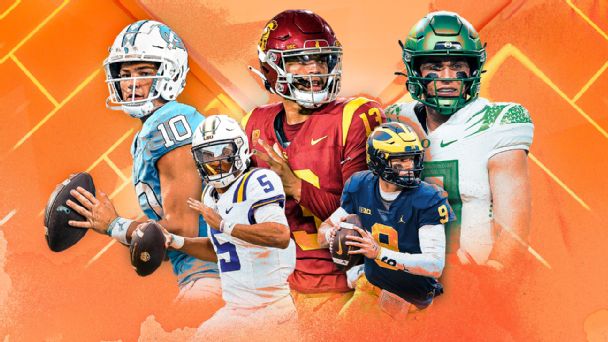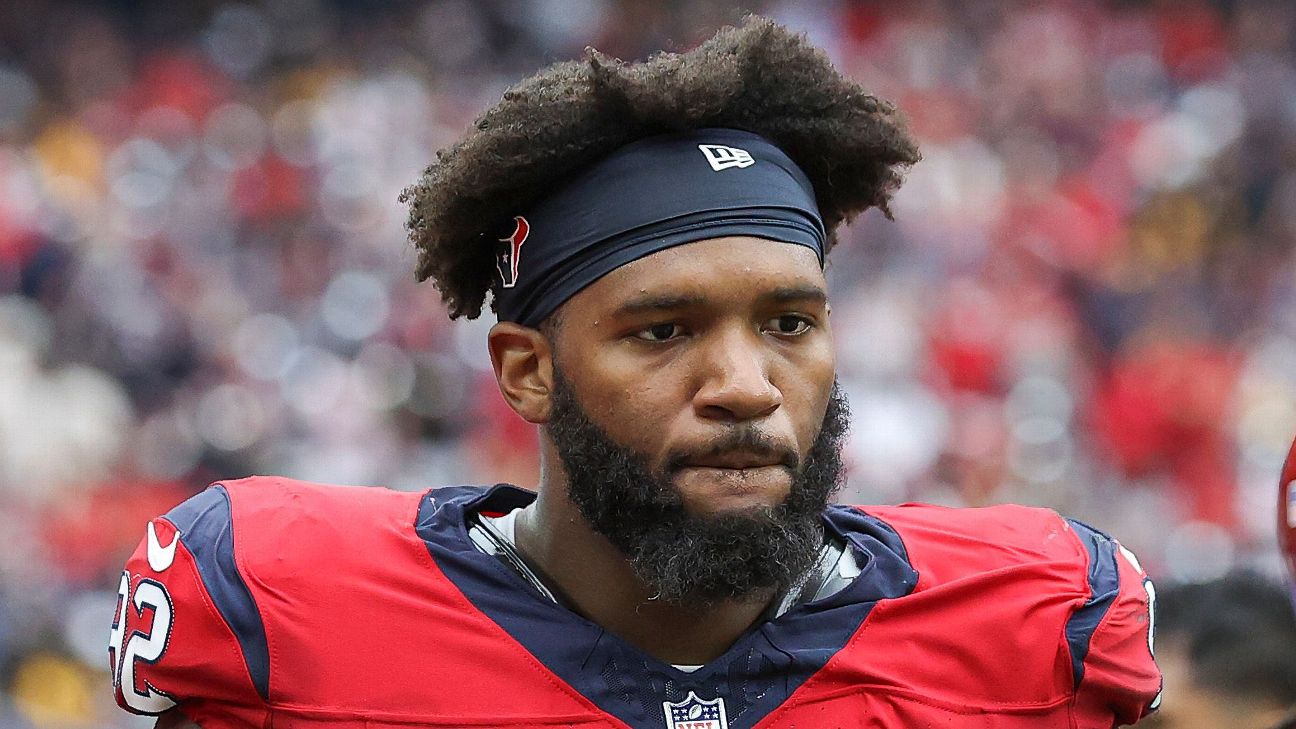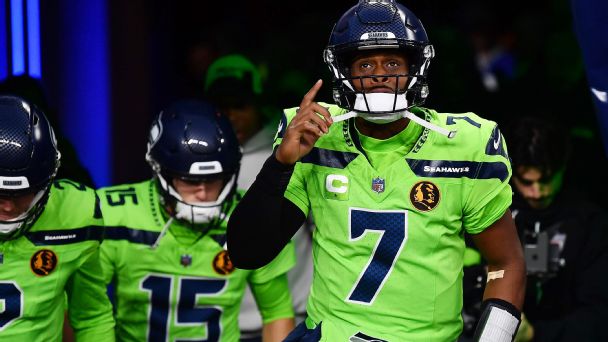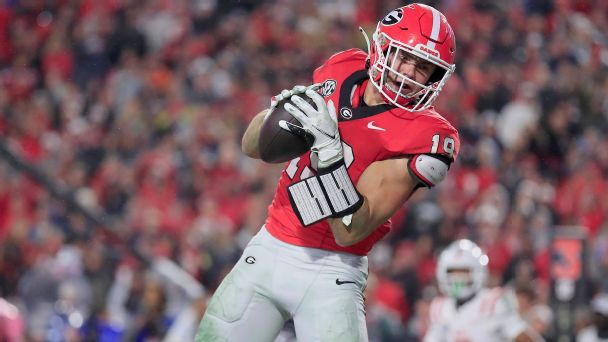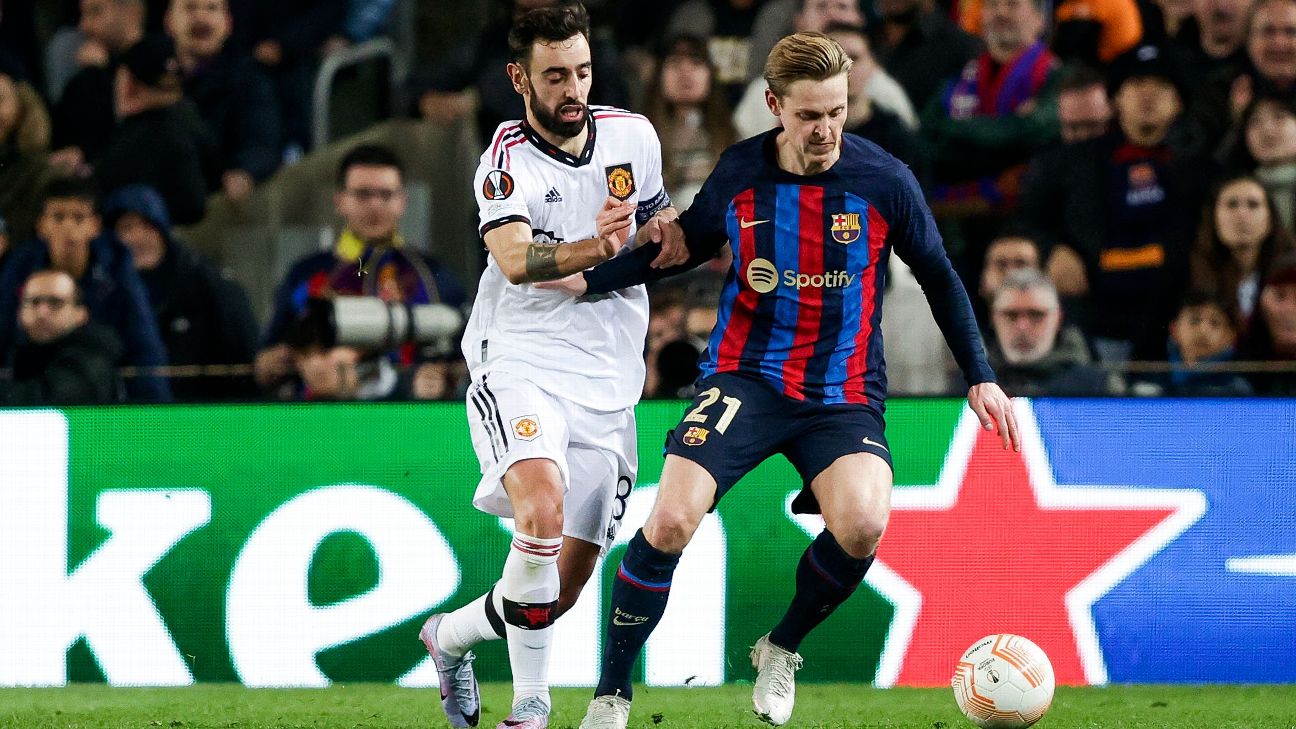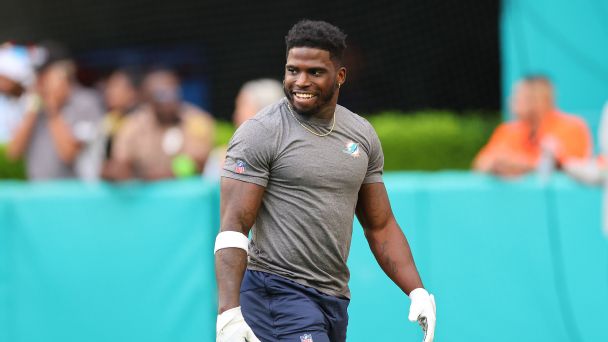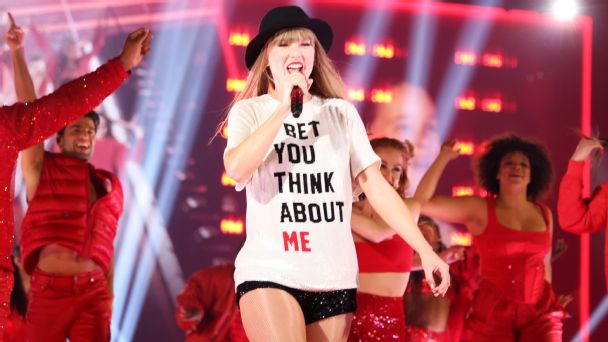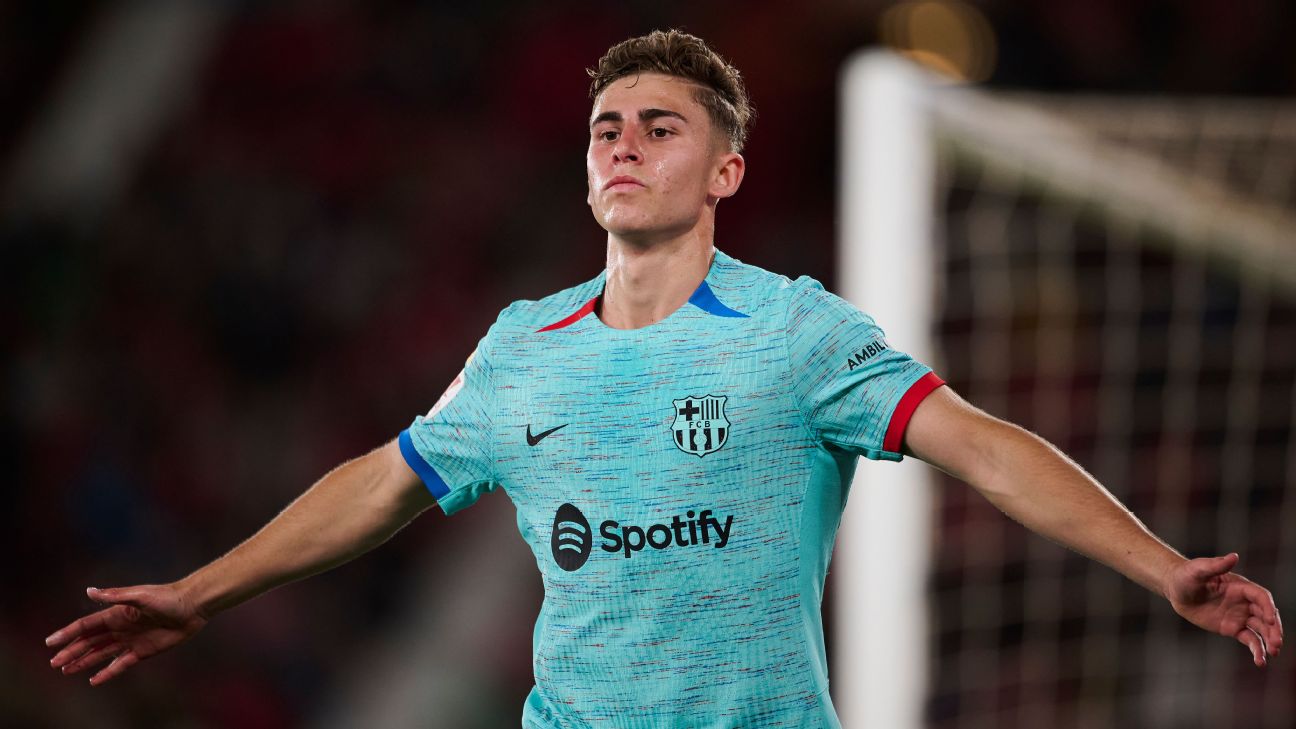![William Contreras, Milwaukee Brewers [608x342]](https://a.espncdn.com/photo/2024/0501/r1327207_608x342_16-9.jpg)
Sunrisers qualify for playoffs after washout against Titans
This time last year, the pitch clock had fundamentally changed baseball, and its effects were wide-ranging. This year, the game has fallen into relatively familiar patterns. The teams that were supposed to be better than everyone -- the Atlanta Braves and the Los Angeles Dodgers -- are on 111- and 98-win paces, respectively. The teams that were supposed to be unwatchable -- the Chicago White Sox and Colorado Rockies -- are positively god-awful. Shohei Ohtani is doing Shohei Ohtani things (at the plate, at least).
Still, every April brings surprises: teams better or worse than expected, breakout stars or faltering veterans. What's real? What isn't? Trying to figure out answers after a month can be a fool's errand, but players, coaches, executives, evaluators and analysts with whom ESPN spoke attempted to put it all into context.
Where to start? With the one group of people that unites baseball fans regardless of team affiliation.
1) The month of the Ump Show -- and how umpires can flip the narrativeToo many times this season -- and to be clear, anything more than zero is too many -- an umpire has become the main character in a baseball game.
Whether it's Angel Hernandez calling strikes on pitches literally a half-foot off the plate or Hunter Wendelstedt kicking New York Yankees manager Aaron Boone out of a game because of what a fan had yelled, April's umpiring gaffes had followers clamoring for the days when robot umpires will arrive in the majors. And, yes, robot umpires are inevitable.
In the meantime, there is a great story for umpires to tell, and this is how they could tell it:
Fifteen years ago, we were straight-up bad at calling balls and strikes. Out of every six pitches thrown, we got one wrong. Pushed by technology and prodded by the league, we got better. Literally every year from 2008-23, the percentage of correct ball-strike calls by umpires has improved. We are not perfect. We are still tracking the hardest-thrown pitches with the most movement in the game's history. But the improvement illustrates how much we care and how much pride we take in pushing ourselves to give baseball and its fans the best umpiring possible.
Here's the thing: That story is completely true. Since the inception of the pitch-tracking era, here, by year, are umpires' correct-call percentages on a rulebook strike zone, according to TruMedia data:
2024 - 92.4%
2023 - 92.8%
2022 - 92.4%
2021 - 92.1%
2020 - 91.7%
2019 - 91.6%
2018 - 91.2%
2017 - 90.4%
2016 - 89.6%
2015 - 89.1%
2014 - 88.6%
2013 - 88.0%
2012 - 87.0%
2011 - 86.3%
2010 - 86.0%
2009 - 85.1%
2008 - 84.4%
Correct-call percentages tend to go up a few tenths of a percent from the first month of the season. But that can't stop a staggering number of incorrect calls based on the rulebook zone as defined by TruMedia. As ESPN Stats & Info's Mike Bonzagni pointed out, umpires missed more than 5,000 ball-strike calls in March and April alone.
Yes, plenty of them were borderline. Plenty of others, though, were Angel-esque. Reigning National League MVP Ronald Acuna Jr. struck out looking four times on pitches out of the zone already this season. So did current American League MVP candidate Gunnar Henderson. In total, 306 called strike threes came on balls, and 35 of them landed so far out of the zone that they were deemed to have a less than 5% likelihood of being called a strike. These are exactly the things technology can -- and soon will -- fix.
The automated ball-strike system (ABS) that has been tested for years in the minor leagues could arrive as soon as next season. MLB has made no commitment to implementing ABS, let alone planning when it would do so, according to officials, but people in decision-making positions throughout the sport believe the league ultimately will adopt the system. Whether it comes in a full version of ABS that calls every pitch (less likely) or in a challenge system that allows players to overturn incorrect ball-strike calls, it's the sort of advancement that can serve as an in-the-moment calibrator and fail-safe against bad judgments.
In the meantime, umpires should showcase their collective improvement at the most difficult part of their current job instead of making #UmpShow trend on social media. A great place to start would be a May when their only noteworthy contribution is a bump in correct-call percentage -- putting them on pace for a 16th straight year of success.
2) New rules are doing what they were intended to do -- mostlyAt this point last year, players were still getting used to the new rules, and their effect on the future of the game was the biggest storyline in the sport. How are those once-radical rules faring now that they have become standard operating procedure?
Let's compare three time periods: March/April of last year, September of last year, March/April of this year.
The good:
After shaving nearly a half hour off games in the clock's first month, players found leeway as the season went on, cutting away some of the gain. So far in 2024, game time is back to almost precisely where it was, in part thanks to an extra two seconds shaved off the clock with runners on. Violations are down by more than half compared to the first month the rules were introduced. Though not as rare as it was by the end of last year, running afoul of the pitching clock simply is not the issue that opponents of it feared. They barely exist. If you get a violation, it's on you. Period. Stolen bases are still up, though attempts have been marginally less successful than last year. Regardless, guys are still running, and Elly De La Cruz is on pace to steal 94, which would help make the Pepper X of spicy takes very, very realistic.The bad:
That BABIP -- batting average on balls in play -- is alarming ... and leads right into the next thing we've noticed so far this season. 3) Offense is headed in the wrong directionEverything about the new rules suggested offense would benefit. The death of the extreme shift. The extra stress the pitch clock places on pitchers. The lack of disengagements. The additional runners in motion. It certainly worked last April. The league OPS (on-base plus slugging) jumped by 50 points year-over-year, a staggering gain.
And perhaps an unrealistic one, due to the sheer dominance of pitchers in this era. Batting average this March and April was back at .240, seven points down from last year. The leaguewide on-base percentage has suffered a similar dip, to .314. Slugging is down 20 points, to .385. Isolated power, home run rate, runs per game -- down, down, down.
Velocity keeps gaining. The average four-seam fastball is now up to 93.9 mph -- harder than it has ever been in any April. And pitchers are throwing less of it than ever anyway, because four-seam fastballs and sinkers are by far the easiest pitches for hitters to square.
Plenty of brilliant offensive performances -- Ohtani, Henderson, Mookie Betts, Juan Soto and Alec Bohm, take a bow -- have helped keep leaguewide numbers from cratering, but the general dominance of pitchers is a defining characteristic of this era. More offense isn't going to come by accident, not when it's so difficult to hit great pitching.
4) Strikeouts are holding steadyStill, there's at least one promising trend for hitters: Strikeout rates in March and April were at 22.5%, the lowest they've been for first-month hitters in well over a half-decade. It's worth asking: Has baseball already hit peak strikeout, and is the game rebalancing itself?
From 2005-20, the strikeout rate rose every year. The new rules were, in part, in response to the three true outcomes taking over the sport -- especially since strikeouts represented a disproportionate amount of those outcomes (home runs and walks being the others). From the 2020 peak of 23.4%, the annual numbers have been 23.2%, 22.4%, 22.7% last year and now 22.5%. Considering strikeout percentages typically dip from March and April numbers as the season progresses, the possibility of a sub-20% strikeout rate for the first time since 2013 is rather unlikely but not entirely far-fetched.
Of course, it's true that the proliferation of injuries to top pitchers has wiped a fair number of would-be strikeouts off the board, but there's reason for optimism here.
5) The bad teams are historically badOver the first 29 days of the season, the White Sox won three games. Over three days last week, the White Sox won three games. Even for a game that specializes in oddities and randomness, baseball rarely offers this sort of stark turnaround.
For the moment, the home sweep against the Tampa Bay Rays has slowed the chatter about Chicago joining the game's all-time dregs and threatening to lose 120-plus games, but the White Sox remain on pace for 131 losses (which would shatter the mark of 120 losses set by the 1962 Mets). Of course, Chicago's excellent weekend included watching the Miami Marlins -- a playoff team last year -- actually dipping beneath the White Sox in the standings. Miami has since steadied itself at 8-24 (a 122-loss pace), joined in the ugliness by the Rockies, whose 7-23 record likewise put Colorado on pace to be the worst team ever.
Never, though, have four teams entered May with a sub-.300 winning percentage. And all that prevented the Astros from joining these three was that they trounced Colorado over the weekend, helping inch Houston's win rate to .333.
How bad can it get for the really bad teams?
For the White Sox, the first 29 days of the season were far more representative of who they are than the three against the Rays. They are still 6-25. They've still given up almost twice as many runs (173) as they've scored (89). They are still prepared to trade just about anyone. And because large-market teams can't participate in the draft lottery in back-to-back years, the earliest they'll select in 2025 is 10th.
It's not much better in Colorado, where the Rockies have allowed a big-league-worst 187 runs and are joined in ignominy by their expansion brethren from Miami, whose collapse in rotation health preceded that for the remainder of the team. All of which is to say: The season is just a month over and this doesn't seem to be scratching the surface of how bad it can get. One team might flirt with 120.
6) Which positive surprise is real?Every year, there are a handful of unexpected teams that spend the first month near the top of the standings. Some are starting season-long runs; others fall off in the months that follow. Let's take a look at this year's possibilities and determine who has the most staying power.
On this list are the teams that lead MLB in run differential (Kansas City Royals) and ERA (Boston Red Sox). The reason the Red Sox are ahead of the Royals in ERA is because Boston's defense has too often butchered and mangled balls in play, leaving unearned runs a significant part of their vibe. We should also include the Cleveland Guardians, Detroit Tigers and Milwaukee Brewers.
And what does every team on this list have in common? A very good bullpen so far. That's new for Kansas City, newish in Detroit, surprising with Boston and de rigueur for Cleveland and Milwaukee. What makes Cleveland and Milwaukee the likeliest teams of this group to succeed isn't the fact that they have the best records of the bunch. No, it goes back to those relievers. For the last half-decade, the Guardians and Brewers almost always find themselves at the top of bullpen rankings.
And while Stephen Vogt and Pat Murphy have taken over for Terry Francona and Craig Counsell and will prove their relief-management magic later on, their acumen so far is laudable, buttressed by unexpected and timely offensive contributions.
7) Which disappointment is most doomed?Of the first month's seven biggest disappointments -- the Arizona Diamondbacks, Astros, San Diego Padres, San Francisco Giants, St. Louis Cardinals, Rays and Toronto Blue Jays -- which is in the most trouble?
Yeah, it's kind of a mess out here for teams with aspirations to contend. On one hand, you've got the Diamondbacks, who are the only NL team among this group with a positive run differential. Then you look at their schedule, and they've won three games by a combined score of 47-3 and been outscored by 26 in their other 29 games. Still, Arizona should be fine -- especially if Corbin Carroll gets going.
The Padres and Giants are repeating 2023 in the worst way. Nothing about them suggests they'll contend; nothing about them suggests "bad enough for the lottery." The Giants can't score runs. The Padres can't prevent them. The Blue Jays' frustration is palpable, particularly with their three best hitters apparently engaged in a contest to see who can dip beneath the Mendoza Line first. St. Louis' offense has been a parade of suck too, and its pitching, outside of a reliable few, hasn't been a whole lot better.
The standouts here might be Houston -- which went to the AL Championship Series last year -- and Tampa Bay, which won 99 games. The Astros have been so banged up in the pitching department that expecting full, healthy returns from the entire staff would be naive, and the Rays just straight up aren't going to be healthy this year, with Shane McClanahan, Jeffrey Springs and Drew Rasmussen all out due to elbow reconstruction. Both of their offenses have black holes. It's just grimmer for the Astros, having to climb out of a deeper basement and having the urgency of an aging roster without much young help on the way.
8) These pitchers are breaking outThis time of year is about looking for details that can separate which surprising starts are one-month flukes and which have season-long staying power. Here are five pitchers you should buy stock in, because what they are doing so far seems very real.
Jared Jones, SP, Pittsburgh Pirates: While everyone is waiting for Paul Skenes to arrive, the Pirates already have perhaps the closest facsimile to his stuff in the big leagues. The 22-year-old Jones, a second-round pick in the 2020 draft, is flashing an absurd array of pitches. His four-seam fastball? Best in the big leagues, as judged by the Stuff+ metric that calculates a pitch's raw qualities. His changeup? Third best. Slider? It's elite too. Curve? Well above average. Oh, and the best part: Jones has walked only five and struck out 42 in 34 innings.
Mason Miller, RP, Oakland Athletics: We're at the point now where a month into the season, Miller still ranks in 12th in MLB in FanGraphs WAR. As a reliever. Who has barely pitched 13⅓ innings while all his brethren on the leaderboard are at 20-plus. This is the sort of stuff that's reserved for the best of the best -- prime Craig Kimbrel, Aroldis Chapman, Kenley Jansen. Tune in for the ninth with the A's. It's worth the time. You never know when you'll see a guy throw 105.
Tarik Skubal, SP, Detroit Tigers: He has been exactly who he was in the second half last year, which is to say the best pitcher in the American League. Don't sleep on Detroit, but especially don't look past Skubal, who will be at the forefront of the Tigers' renaissance.
Logan Gilbert, SP, Seattle Mariners: He is one of the most gifted pitchers in the big leagues, not just at maximizing his potential but expanding on it. In each of the past two winters, Gilbert has learned a new pitch, and both have instantly become huge parts of his repertoire. Last year was the splitter. This year, it's the cutter. And he now throws them a combined third of the time. It's growth and evolution, sure, but it's damn impressive just to have the gumption to take something that's already good and make it better.
James McArthur, RP, Kansas City Royals: Mixing evenly a sinker, slider and curveball, the 6-foot-7 McArthur has grabbed the Royals' closing job after Will Smith ceded it within the season's first week. McArthur hasn't given up a run since, and the precision of the breaking balls and willingness to run the fastball inside makes him the latest find for Kansas City, which acquired him last year from Philadelphia for cash and a 20-year-old rookie ball outfielder.
9) And so are these hittersLikewise, here are five hitters you should believe in:
Ryan O'Hearn, 1B, Baltimore Orioles: You take your Adleys, your Gunnars, your Coltons, your Jordans. Among the kids is the geezer of the bunch, all of 30 years old, who also is wrecking shop and has a Baseball Savant page so filled with red that it looks like a crime scene. O'Hearn's story is great. Got cut by Kansas City. Went to Baltimore. Figured out some things. Found his role as a masher of right-handed pitching. Doesn't strike out. And made something all of the expected numbers suggest is very real, very sustainable and very loud.
Tyler O'Neill, OF, Boston Red Sox: Speaking of guys who figured something out, this is an upgraded version of the O'Neill who three years ago finished eighth in NL MVP voting. His approach is clear: He has become incredibly choosy at the plate to find a pitch he can elevate. O'Neill is swinging at just 39.7% of pitches, 15th of 203 players with at least 90 plate appearances -- and well below his career mark entering the season of 48.1%. This is how a player relegated to backup duty in St. Louis becomes a star again.
Josh Naylor, 1B, Cleveland Guardians: Speaking of Statcast darlings, Naylor is one of five players with an 89th-percentile-plus expected weighted on-base average (xwOBA) and strikeout rate. His company is dude after dude: Soto, Betts, O'Hearn and Salvador Perez. The formula is pretty simple: hit the ball hard, put it in play and make All-Star teams. Naylor has been a productive player three years' running, and in his age-27 season, the peak version of him might have arrived.
Elly De La Cruz, SS, Cincinnati Reds: By now you know all about the 22-year-old switch-hitting, tank-dropping, Olympic-caliber-sprinting force of nature. What's most fascinating about him, in this moment, is how he defies his comparables. Like Kyle Schwarber, Aaron Judge and Joey Gallo, De La Cruz walks a lot, swings and misses a lot, and strikes out a lot. Unlike his three peers, De La Cruz is managing to cobble together an excellent batting average despite chasing outside the zone more than them. The sustainability will make the difference between merely a great season and an MVP year.
Salvador Perez, C, Kansas City Royals: Little is more enjoyable than watching a guy who is about to turn 34 years old put together another monster season that might sway nonbelievers into his Hall of Fame case. With Joe Mauer going into Cooperstown and Perez owning more Gold Gloves and All-Star appearances, a World Series MVP and nearly twice the home runs, another good season for Perez -- who leads the AL in RBIs -- could go a long way to overcoming the biggest impediment to his candidacy: a lifetime on-base percentage hovering around .300.
10) Players who would like a do-overFor all of those hot starters, here are five guys who would love to pretend April never existed:
Jose Abreu, 1B, Houston Astros: The 37-year-old, who hadn't played a day in the minor leagues during his 11-year major league career, is headed to the Astros' spring training facility in Florida for a reset after failing to hit .100 over the season's first month. Perhaps Astros owner Jim Crane would have benefitted from having a general manager during the two-week period in November 2022 when he negotiated $93 million worth of guarantees for Abreu and reliever Rafael Montero.
Randy Arozarena, OF, Tampa Bay Rays: Unlike Abreu, Arozarena is not losing his job. The Rays don't have much to replace him. But Arozarena's struggles this year (a .139/.220/.235 line, good for fourth worst in MLB) aren't simply bad luck or misfortune. He's swinging and missing more than ever. He's not hitting the ball as hard. It's a litany of issues that, though solvable, need a solution sooner rather than later.
Kyle Hendricks, SP, Chicago Cubs: For all of the focus on Hendricks' fastball velocity -- he has, for years, been the softest-tossing starter in the big leagues -- the 88.2 mph average on his heater is the hardest he has thrown in 10 years. It's also getting turned around with problematic regularity, as a 12.00 ERA and eight home runs allowed in 21 innings are suboptimal. Hendricks has the brain to work out anything. It's time to see if his body can do what's necessary to make it right.
Vladimir Guerrero Jr., 1B, Toronto Blue Jays: Every player is entitled to a bad month. It's just that Guerrero has had a lot of bad months. Since his MVP-caliber 2021 season, he has made a pair of All-Star teams and hit plenty of home runs. But how much success has there really been? He's 0-for-3 in playoff series. His consistency is AWOL. He's 25, one year from free agency. Guerrero might still hit the ball harder than just about anyone on the planet, but at some point, exit velocity is just a number that isn't translating into anything that matters.
Blake Snell, SP, San Francisco Giants: Snell got off to a disastrous start last year and made this ignominious list. From that point forward, he went 14-5 with a 1.78 ERA, held hitters to a .165/.275/.247 line and won the NL Cy Young Award. In his three starts with the Giants this season, Snell is 0-3 with an 11.57 ERA, and he is currently on the injured list with a mild groin strain. San Francisco can only pray the list treats him similarly this season.


